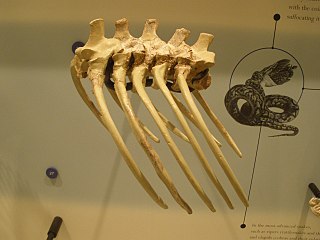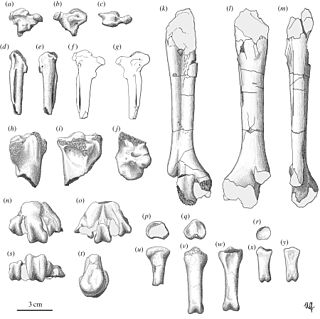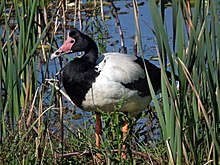
A passerine is any bird of the order Passeriformes, which includes more than half of all bird species. Sometimes known as perching birds, passerines generally have an anisodactyl arrangement of their toes, which facilitates perching.

A goose is a bird of any of several waterfowl species in the family Anatidae. This group comprises the genera Anser and Branta. Some other birds, mostly related to the shelducks, have "goose" as part of their names. More distantly related members of the family Anatidae are swans, most of which are larger than true geese, and ducks, which are smaller.

A phalarope is any of three living species of slender-necked shorebirds in the genus Phalaropus of the bird family Scolopacidae.

The Anatidae are the biological family of water birds that includes ducks, geese, and swans. The family has a cosmopolitan distribution, occurring on all the world's continents except Antarctica. These birds are adapted for swimming, floating on the water surface, and in some cases diving in at least shallow water. The family contains around 174 species in 43 genera.

Anseriformes is an order of birds also known as waterfowl that comprises about 180 living species of birds in three families: Anhimidae, Anseranatidae, and Anatidae, the largest family, which includes over 170 species of waterfowl, among them the ducks, geese, and swans. Most modern species in the order are highly adapted for an aquatic existence at the water surface. With the exception of screamers, males have penises, a trait that has been lost in the Neoaves. Due to their aquatic nature, most species are web-footed.

Rails are a large, cosmopolitan family of small- to medium-sized terrestrial and/or semi-amphibious birds. The family exhibits considerable diversity in its forms, and includes such ubiquitous species as the crakes, coots, and gallinule; other rail species are extremely rare or endangered. Many are associated with wetland habitats, some being semi-aquatic like waterfowl, but many more are wading birds or shorebirds. The ideal rail habitats are marsh areas, including rice paddies, and flooded fields or open forest. They are especially fond of dense vegetation for nesting. The rail family is found in every terrestrial habitat with the exception of dry desert, polar or freezing regions, and alpine areas. Members of Rallidae occur on every continent except Antarctica. Numerous unique island species are known.

The screamers are three South American bird species placed in family Anhimidae. They were thought to be related to the Galliformes because of similar bills, but are more closely related to ducks, and most closely related to the magpie goose. The clade is exceptional within the living birds in lacking uncinate processes of ribs. The three species are: The horned screamer ; the southern screamer or crested screamer ; and the northern screamer or black-necked screamer.

The Oxyurini are a tribe of the duck subfamily of birds, the Anatinae. It has been subject of considerable debate about its validity and circumscription. Some taxonomic authorities place the group in its own subfamily, the Oxyurinae. Most of its members have long, stiff tail feathers which are erected when the bird is at rest, and relatively large, swollen bills. Though their relationships are still enigmatic, they appear to be closer to swans and true geese than to the typical ducks. The highest diversity is found in the warmer parts of the Americas, but at least one species occurs in a major part of the world.

The magpie goose is the sole living representative species of the family Anseranatidae. This common waterbird is found in northern Australia and southern New Guinea. As the species is prone to wandering, especially when not breeding, it is sometimes recorded outside its core range. The species was once also widespread in southern Australia but disappeared from there largely due to the drainage of the wetlands where the birds once bred. Due to their importance to Aboriginal people as a seasonal food source, as subjects of recreational hunting, and as a tourist attraction, their expansive and stable presence in northern Australia has been "ensured [by] protective management".

The black geese of the genus Branta are waterfowl belonging to the true geese and swans subfamily Anserinae. They occur in the northern coastal regions of the Palearctic and all over North America, migrating to more southernly coasts in winter, and as resident birds in the Hawaiian Islands. Alone in the Southern Hemisphere, a self-sustaining feral population derived from introduced Canada geese is also found in New Zealand.

Anas is a genus of dabbling ducks. It includes the pintails, most teals, and the mallard and its close relatives. It formerly included additional species but following the publication of a molecular phylogenetic study in 2009 the genus was split into four separate genera. The genus now contains 31 living species. The name Anas is the Latin for "duck".

Anser is a waterfowl genus that includes the grey geese and the white geese. It belongs to the true goose and swan subfamily of Anserinae under the family of Anatidae. The genus has a Holarctic distribution, with at least one species breeding in any open, wet habitats in the subarctic and cool temperate regions of the Northern Hemisphere in summer. Some also breed farther south, reaching into warm temperate regions. They mostly migrate south in winter, typically to regions in the temperate zone between the January 0 °C (32 °F) and 5 °C (41 °F) isotherms.

Madtsoiidae is an extinct family of mostly Gondwanan snakes with a fossil record extending from early Cenomanian to late Pleistocene strata located in South America, Africa, India, Australia and Southern Europe. Madtsoiidae include very primitive snakes, which like extant boas and pythons would likely dispatch their prey by constriction. Genera include Madtsoia, one of the longest snakes known, at an estimated 10 metres (33 ft), and the Australian Wonambi and Yurlunggur. As a grouping of basal forms the composition and even the validity of Madtsoiidae is in a state of flux as new pertinent finds are described, with more recent evidence suggesting that it is paraphyletic as previously defined.

Créchy is a commune in the Allier department in central France.
Eoanseranas handae, also sometimes referred to as Hand's dawn magpie goose, is an extinct genus and species of bird. Allied to the family Anseranatidae, which are represented by modern magpie geese, it existed during the Late Oligocene or Early Miocene of northern Australia. It was described from fossil material found at a Carl Creek Limestone site at Riversleigh, in the Boodjamulla National Park of northwestern Queensland. It was slightly smaller than its perceived descendant, the extant magpie goose Anseranas semipalmata.

Garganornis is an extinct genus of enormous flightless anatid waterfowl from the Late Miocene of Gargano, Italy. The genus contains one species, G. ballmanni, named by Meijer in 2014. Its enormous size is thought to have been an adaptation to living in exposed, open areas with no terrestrial predators, and as a deterrent to the indigenous aerial predators like the eagle Garganoaetus and the giant barn owl Tyto gigantea.
Chaunoides is an extinct genus of screamer. Only one species of this genus is known, namely Chaunoides antiquus.
Suzanne J. Hand is an associate professor at the University of New South Wales, a teacher of geology and biology, who has a special interest in vertebrate palaeontology and modern mammals. Her research has been published in over a hundred articles, and is especially focused on the subjects of evolutionary biology, functional morphology, phylogenetics, and biogeography. Hand is a co-leader of the research team investigating the Riversleigh World Heritage Area, regarded as one of the four most important sites of fossil-bearing formations in the world.















